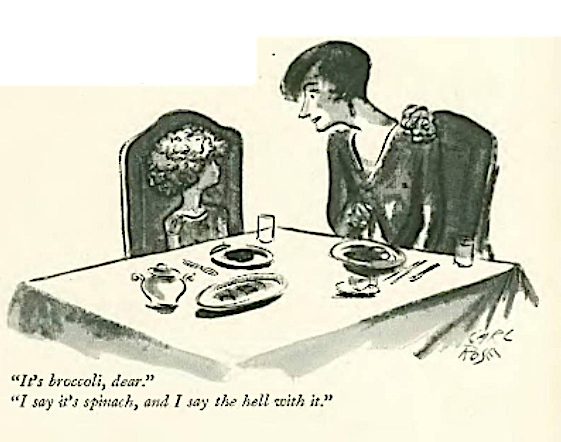First and Last… Carl Rose
Carl Rose, who likely will always be associated with E.B. White for the drawing directly below, (it was published in The New Yorker, December 8, 1928), had a long and bountiful career at the magazine; 543 cartoons published* over 46 years.
My interest in New Yorker artist’s careers and lives often causes me to take a look at an artist’s very first published New Yorker drawing, and, sadly, their very last. I like to think about how the artist felt when their first drawing appeared. In Mr. Rose’s case, with The New Yorker only nine months old, and not even close to the status it eventually achieved as a home for writers and artists, we might allow ourselves to speculate that his first published New Yorker drawing may have been just another market for his work. But that wasn’t the case. Thankfully, Rose himself has left a record of his thoughts about his first sale; it appears in his only collection, One Dozen Roses:
“[Harold] Ross bought the first drawing I ever managed to sell. It was a wretched little sketch, completely amateurish. A man, rock tied around his neck, was jumping from one of the East River bridges. Behind him, a falling taxicab, its driver calling, “Taxi, sir?” Don’t look for it in this volume. It isn’t even that good. But when the check came for it, I considered myself in. I now suspect it was a come-on — a sort of editorial loss-leader. But it was a break. It stimulated the secretion of ideas.”
Here’s Carl Rose’s “wretched little sketch.” It appeared in the issue of October 31, 1925. If he hadn’t signed it, I wouldn’t have recognized it as one of his drawings.
And here’s his last New Yorker drawing, helpfully wrapped within his obit, written by Brendan Gill. You don’t see this too often in the magazine. I can’t recall seeing it done before Rose’s last drawing (but I’ve seen it since).
_____________________________________________________________________________
Here’s Carl Rose’s A-Z entry:


Carl Rose (photo above) Born, New York City; died, Rowayton, Ct., June 20, 1971, age 68. New Yorker work: 1925 – 1971. Collection; One Dozen Roses (Random House, 1946). Note: this collection contains essays by Rose on cartoon themes. Especially of interest is his essay concerning Harold Ross, “An Artist’s Best Friend is His Editor”. Carl Rose will forever be linked to E.B. White for the December 8, 1928 New Yorker cartoon of the mother saying to her child, “It’s broccoli, dear.” and the child responding, “I say it’s spinach, and I say the hell with it.” The drawing was by Rose, the caption was adapted by White from Rose’s original idea (for a slighty expanded explanation go here). Rose also had a Thurber connection. In 1932, Rose submitted a drawing captioned, “Touche!” of two fencers, one of whom has just cut off the head of the other. Harold Ross ( according to Thurber in The Years With Ross) thinking the Rose version “too bloody” suggested Thurber do the drawing because “Thurber’s people have no blood. You can put their heads back on and they’re as good as new.” The drawing appeared December 3, 1932.
_____________________________________________________________________________
*The New Yorker database lists his published work at 543. Gill says the last drawing was one of the “more than 600 he made for us.” “Made for us” implies, I believe, work bought, but not necessarily published. This presents, for me, an interesting dilemma, accounting-wise. When it concerns artists from way back in the magazine’s lifespan we can’t know how many drawings they sold to The New Yorker. I’ve never seen such a record of sales in the magazine’s archives in The New York Public Library (the present day New Yorker keeps a record of contemporary artists contributions, but it’s not public). When I talk about #s of work for the artists of yore, I’m limited to talking about published work as indicated in the database, not all work sold in a career. I do not know where Mr. Gill got “more than 600” — perhaps, in 1971, there was an accounting that was not moved to the archive. Or, perhaps it was an approximation. We can’t assume, for deceased cartoonists, there are more bought, but not published, pieces left “on the bank.” I know there are, in some cases. If I know, I’ll indicate it. But unless I know for certain, we’ll stick with published #s. Whew.



